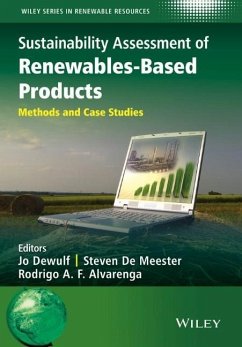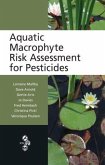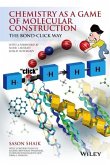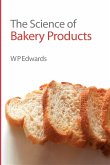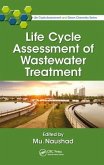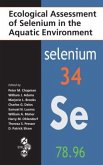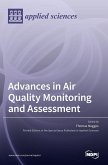Sustainability Assessment of Renewables-Based Products
Methods and Case Studies
Herausgeber: Dewulf, Jo; Alvarenga, Rodrigo A F; De Meester, Steven
Sustainability Assessment of Renewables-Based Products
Methods and Case Studies
Herausgeber: Dewulf, Jo; Alvarenga, Rodrigo A F; De Meester, Steven
- Gebundenes Buch
- Merkliste
- Auf die Merkliste
- Bewerten Bewerten
- Teilen
- Produkt teilen
- Produkterinnerung
- Produkterinnerung
Over the past decade, renewables-based technology and sustainability assessment methods have grown tremendously. Renewable energy and products have a significant role in the market today, and the same time sustainability assessment methods have advanced, with a growing standardization of environmental sustainability metrics and consideration of social issues as part of the assessment. Sustainability Assessment of Renewables-Based Products: Methods and Case Studies is an extensive update and sequel to the 2006 title Renewables-Based Technology: Sustainability Assessment. It discusses the…mehr
Andere Kunden interessierten sich auch für
![Aquatic Macrophyte Risk Assessment for Pesticides Aquatic Macrophyte Risk Assessment for Pesticides]() Lorraine MaltbyAquatic Macrophyte Risk Assessment for Pesticides220,99 €
Lorraine MaltbyAquatic Macrophyte Risk Assessment for Pesticides220,99 €![Chemistry as a Game of Molecular Construction Chemistry as a Game of Molecular Construction]() Sason ShaikChemistry as a Game of Molecular Construction96,99 €
Sason ShaikChemistry as a Game of Molecular Construction96,99 €![Science of Bakery Products Science of Bakery Products]() William P EdwardsScience of Bakery Products38,99 €
William P EdwardsScience of Bakery Products38,99 €![Life Cycle Assessment of Wastewater Treatment Life Cycle Assessment of Wastewater Treatment]() Life Cycle Assessment of Wastewater Treatment238,99 €
Life Cycle Assessment of Wastewater Treatment238,99 €![Allen's Commercial Organic Analysis; a Treatise on the Properties, Modes of Assaying, and Proximate Analytical Examination of the Various Organic Chemicals and Products Employed in the Arts, Manufactures, Medicine, etc., With Concise Methods for the Detec Allen's Commercial Organic Analysis; a Treatise on the Properties, Modes of Assaying, and Proximate Analytical Examination of the Various Organic Chemicals and Products Employed in the Arts, Manufactures, Medicine, etc., With Concise Methods for the Detec]() Alfred Henry AllenAllen's Commercial Organic Analysis; a Treatise on the Properties, Modes of Assaying, and Proximate Analytical Examination of the Various Organic Chemicals and Products Employed in the Arts, Manufactures, Medicine, etc., With Concise Methods for the Detec50,99 €
Alfred Henry AllenAllen's Commercial Organic Analysis; a Treatise on the Properties, Modes of Assaying, and Proximate Analytical Examination of the Various Organic Chemicals and Products Employed in the Arts, Manufactures, Medicine, etc., With Concise Methods for the Detec50,99 €![Ecological Assessment of Selenium in the Aquatic Environment Ecological Assessment of Selenium in the Aquatic Environment]() Ecological Assessment of Selenium in the Aquatic Environment242,99 €
Ecological Assessment of Selenium in the Aquatic Environment242,99 €![Advances in Air Quality Monitoring and Assessment Advances in Air Quality Monitoring and Assessment]() Advances in Air Quality Monitoring and Assessment59,99 €
Advances in Air Quality Monitoring and Assessment59,99 €-
-
-
Over the past decade, renewables-based technology and sustainability assessment methods have grown tremendously. Renewable energy and products have a significant role in the market today, and the same time sustainability assessment methods have advanced, with a growing standardization of environmental sustainability metrics and consideration of social issues as part of the assessment. Sustainability Assessment of Renewables-Based Products: Methods and Case Studies is an extensive update and sequel to the 2006 title Renewables-Based Technology: Sustainability Assessment. It discusses the impressive evolution and role renewables have taken in our modern society, highlighting the importance of sustainability principles in the design phase of renewable-based technologies, and presenting a wide range of sustainability assessment methods suitable for renewables-based technologies, together with case studies to demonstrate their applications. This book is a valuable resource for academics, businesses and policy makers who are active in contributing to more sustainable production and consumption. For more information on the Wiley Series in Renewable Resources, visit www.wiley.com/go/rrs Topics covered include: * The growing role of renewables in our society * Sustainability in the design phase of products and processes * Principles of sustainability assessment * Land use analysis * Water use analysis * Material and energy flow analysis * Exergy and cumulative exergy analysisCarbon and environmental footprint methods * Life Cycle Assessment (LCA), social Life Cycle Assessment and Life Cycle Costing (LCC) * Case studies: renewable energy, bio-based chemicals and bio-based materials.
Hinweis: Dieser Artikel kann nur an eine deutsche Lieferadresse ausgeliefert werden.
Hinweis: Dieser Artikel kann nur an eine deutsche Lieferadresse ausgeliefert werden.
Produktdetails
- Produktdetails
- Verlag: John Wiley & Sons / Wiley
- Seitenzahl: 400
- Erscheinungstermin: 19. Januar 2016
- Englisch
- Abmessung: 244mm x 168mm x 25mm
- Gewicht: 726g
- ISBN-13: 9781118933947
- ISBN-10: 111893394X
- Artikelnr.: 42999332
- Herstellerkennzeichnung
- Libri GmbH
- Europaallee 1
- 36244 Bad Hersfeld
- gpsr@libri.de
- Verlag: John Wiley & Sons / Wiley
- Seitenzahl: 400
- Erscheinungstermin: 19. Januar 2016
- Englisch
- Abmessung: 244mm x 168mm x 25mm
- Gewicht: 726g
- ISBN-13: 9781118933947
- ISBN-10: 111893394X
- Artikelnr.: 42999332
- Herstellerkennzeichnung
- Libri GmbH
- Europaallee 1
- 36244 Bad Hersfeld
- gpsr@libri.de
Prof. Dr. Jo Dewulf, Institute for Environment and Sustainability, JRC, European Commision, Italy and Sustainable Organic Chemistry and Technology, Ghent University, Belgium Professor Dewulf performs research in the areas of environmental chemistry, environmental technology and clean technology at Ghent University. Since December 2013, he has been working as a senior researcher in the Institute for Environment and Sustainability at the Joint Research Institute of the European Commission. Key in his work is managing natural resources in a technically efficient way, performing thermodynamics based sustainability analysis at process, plant and cradle-to-gate level to support the development and assessment of new technologies. Supported by: Dr Steven De Meester, Sustainable Organic Chemistry and Technology, Ghent University, Belgium Dr De Meester works on the development of sustainability assessment methodologies for new technologies and applications of Life Cycle Assessment in industry. Dr Rodrigo Alvarenga, Universidade Federal de Santa Catarina, Brazil
List of Contributors xvii
Series Editor's Preface xxiii
Preface xxvii
1 The Growing Role of Biomass for Future Resource Supply-Prospects and
Pitfalls 1
Helmut Haberl
1.1 Introduction 1
1.2 Global Ecological and Socioeconomic Biomass Flows 3
1.3 Global Biomass Potentials in 2050 5
1.4 Critical Socio?-Ecological Feedbacks and Sustainability Issues 9
1.5 Conclusions 12
Acknowledgements 12
References 13
2 The Growing Role of Photovoltaic Solar, Wind and Geothermal Energy as
Renewables for Electricity Generation 19
W.G.J.H.M. van Sark, J.G. Schepers, and J.D.A.M. van Wees
2.1 General Introduction 19
2.2 Photovoltaic Solar Energy 21
2.3 Wind Energy 24
2.4 Geothermal Energy 28
2.5 Conclusion 33
References 34
3 Assessment of Sustainability within Holistic Process Design 37
Alexei Lapkin, Philipp?]Maximilian Jacob, Polina Yaseneva, Charles Gordon,
and Amy Peace
3.1 Introduction: Holistic Process Design from Unit Operations to Systems
Science Methods 37
3.2 Use of Life Cycle Assessment in Holistic Process Design 40
3.3 A Decision?-Tree Methodology for Complex Process Design 41
3.4 Generation of New Synthesis Routes in Bio?-Based Supply Chains 45
3.5 Conclusions 47
Acknowledgements 48
References 48
4 A Mass Balance Approach to Link Sustainable Renewable Resources in
Chemical Synthesis with Market Demand 51
Claudius Kormann and Andreas Kicherer
4.1 Introduction 51
4.2 Renewable Feedstock: Market Drivers, Political Frame 52
4.3 Traceability of Biomass as Feedstock in the Chemical Industry 53
4.4 Standard of Mass Balance in Chemical Synthesis 57
4.5 Sustainability Aspects of Renewable Resources 60
4.6 Discussion 61
4.7 Vision and Summary 62
References 63
5 Early R&D Stage Sustainability Assessment: The 5? Pillar Method 65
Akshay D. Patel, John A. Posada, Li Shen, and Martin K. Patel
5.1 Introduction 65
5.2 Methodology 67
5.3 Case Study 73
5.4 Validation Case Study 75
5.5 Critical Review and Outlook 76
5.6 Conclusion 79
References 79
6 Assessing the Sustainability of Land Use: A Systems Approach 81
Miguel Brandão
6.1 Introduction 81
6.2 Methodological Issue 1: Consequential Analysis of Land Use Decisions 82
6.3 Methodological Issue 2: Land Use Impacts on Ecosystems 87
6.4 Methodological Issue 3: Land Use Impacts on Climate 89
6.5 Methodological Issue 4: Economic and Social Impact Assessment 90
6.6 Methodological Issue 5: Integrating Environmental and Economic
Assessments 92
6.7 Discussion 93
6.8 Conclusions 94
References 94
7 Water Use Analysis 97
Francesca Verones, Stephan Pfister, and Markus Berger
7.1 Introduction 97
7.2 Methods and Tools for Assessing the Sustainable Use of Water 98
7.3 Case Study: Water Consumption Analysis of Biofuels and Fossil Fuels 102
7.4 Discussion and Conclusion 105
References 106
8 Material Intensity of Food Production and Consumption 109
Lucia Mancini and Michael Lettenmeier
8.1 Introduction 109
8.2 Material Flow Based Approaches for Assessing Sustainable Production and
Consumption Systems 110
8.3 MIPS Concept and Methodology 111
8.4 Material Intensity of Food Systems 113
8.5 Results of MIPS for Agricultural Products and Foodstuffs 118
8.6 Conclusions 121
References 122
9 Material and Energy Flow Analysis 125
Goto Naohiro, Nova Ulhasanah, Hirotsugu Kamahara, Udin Hasanudin, Ryuichi
Tachibana, and Koichi Fujie
9.1 Background 125
9.2 Methodology 128
9.3 Case Study 131
9.4 Conclusion 139
Acknowledgements 139
References 139
10 Exergy and Cumulative Exergy Use Analysis 141
Sofie Huysman, Thomas Schaubroeck, and Jo Dewulf
10.1 What Is Exergy 141
10.2 Calculation of Exergy 142
10.3 Applications of Exergy 144
10.4 Cumulative Exergy Use Analysis 146
10.5 Conclusions 151
References 152
11 Carbon and Environmental Footprint Methods for Renewables? based
Products and Transition Pathways to 2050 155
Geoffrey P. Hammond
11.1 Introduction 155
11.2 Carbon and Environmental (or Eco) Footprinting 159
11.3 The Relationship between Environmental Footprint Analysis (EFA) and
Environmental Life?]Cycle Assessment (LCA) 166
11.4 Carbon and Environmental Footprints Associated with Global Biofuel
Production 167
11.5 Carbon and Environmental Footprints of Low Carbon Transition Pathways
171
11.6 Concluding Remarks 174
Acknowledgements 175
References 176
12 Tracking Supply and Demand of Biocapacity through Ecological Footprint
Accounting 179
David Lin, Alessandro Galli, Michael Borucke, Elias Lazarus, Nicole
Grunewald, Jon Martindill, David Zimmerman, Serena Mancini, Katsunori Iha,
and Mathis Wackernagel
12.1 Summary and Rationale 179
12.2 Methodology 182
12.3 Usage Recommendations 193
12.4 Future Developments 195
References 195
13 Life Cycle Assessment and Sustainability Supporting Decision Making by
Business and Policy 201
Sala Serenella, Fabrice Mathieux, and Rana Pant
13.1 Life Cycle Assessment: A Systemic Approach to Evaluate Impacts 201
13.2 LCA: Supporting Sustainability Assessment 205
13.3 Role of LCA in Supporting Decisions in Business and Policy Context 206
13.4 Tools and Support to Put LCA into Practice 210
13.5 Conclusion and the Way Forward 211
Acknowledgements 211
References 212
14 Life Cycle Costing 215
Andreas Ciroth, Jutta Hildenbrand, and Bengt Steen
14.1 Life Cycle Costing - Definition and Principles 215
14.2 Environmental LCC 216
14.3 Societal LCC 220
14.4 LCC and Renewables 221
14.5 Example Case 222
References 228
15 Social Life Cycle Assessment: Methodologies and Practice 229
Alessandra Zamagni, Pauline Feschet, Anna Irene De Luca, Nathalie Iofrida,
and Patrizia Buttol
15.1 Introduction 229
15.2 Social Life Cycle Assessment: Scientific Background 230
15.3 Social Life Cycle Assessment in Practice 232
15.4 SLCA and Life Cycle Sustainability Assessment: Methodological
Challenges 234
15.5 Conclusions and Outlook 236
References 237
16 Life Cycle Assessment of Solar Technologies 241
F. Ardente, M. Cellura, S. Longo, and M. Mistretta
16.1 Introduction 241
16.2 Solar Technologies 242
16.3 Life Cycle Assessment (LCA) and Solar Technologies 245
16.3.1 Solar Thermal Plants 246
16.3.2 Photovoltaic Plants 246
16.3.3 Concentrating Solar Power (CSP) Plants and Solar Heating/Cooling
Plants 249
16.4 Assessment of Solar Technologies 249
16.5 Conclusions 256
References 256
17 Assessing the Sustainability of Geothermal Utilization 259
Ruth Shortall, Gudni Axelsson, and Brynhildur Davidsdottir
17.1 Introduction 259
17.2 Sustainable Geothermal Utilization 260
17.3 Broader Sustainability Assessment of Energy Developments 266
17.4 Sustainability Assessment Framework for Geothermal Power 266
17.5 Conclusion 271
References 271
18 Biofuels from Terrestrial Biomass: Sustainability Assessment of
Sugarcane Biorefineries in Brazil 275
Otavio Cavalett, Marcos D.B. Watanabe, Alexandre Souza, Mateus F. Chagas,
Tassia L. Junqueira, and Antonio Bonomi
18.1 Introduction 275
18.2 The Virtual Sugarcane Biorefinery (VSB) 276
18.3 Methods Used in the VSB 277
18.4 Biorefinery Scenarios Case Study 279
18.5 Final Remarks 286
Acknowledgements 286
References 287
19 Algae as Promising Biofeedstock; Searching for Sustainable Production
Processes and Market Applications 289
Sue Ellen Taelman, Steven De Meester, and Jo Dewulf
19.1 Introduction 289
19.2 Algae Background 290
19.3 Algal Cultivation and Processing Methods 292
19.4 Algae: Production and Potential Applications 294
19.5 Environmental Sustainability of Algae Production 298
19.6 Conclusions 302
References 303
20 Life Cycle Assessment of Biobased and Fossil? Based Succinic Acid 307
Marieke Smidt, Jeroen den Hollander, Henk Bosch, Yang Xiang, Maarten van
der Graaf, Anne Lambin, and Jean?]Pierre Duda
20.1 Production of Succinic Acid 307
20.2 Life Cycle Assessment: Biobased Succinic Acid and Fossil?]Based
Equivalent 310
20.3 Sensitivity Analysis 316
20.4 Conclusions 319
References 320
21 Biobased Poly Vinylchloride (PVC) 323
Rodrigo A.F. Alvarenga, Zdenek Hruska, Alain Wathelet, and Jo Dewulf
21.1 Introduction 323
21.2 Life Cycle Assessment of Biobased PVC 324
21.3 Carbon Footprint of Biobased Product 329
21.4 Environmental Sustainability of Bioethanol Use 330
21.5 Conclusions 331
References 332
22 Evaluation of Wood Cascading 335
Karin Höglmeier, Gabriele Weber?-Blaschke, and Klaus Richter
22.1 Introduction 335
22.2 Environmental Assessment of Wood Cascading by LCA 338
22.3 Discussion and Conclusion 343
Acknowledgements 345
References 345
23 Time?]Dependent Life? Cycle Assessment of Bio?-Based Packaging Materials
347
Maartje N. Sevenster
23.1 Introduction 347
23.2 Methodology 351
23.3 Results 353
23.4 Discussion 357
23.5 Conclusions 358
References 358
24 Conclusions 361
Jo Dewulf
24.1 The Importance of Renewables?]Based Products and Services 361
24.2 The Need for Sustainability Assessment for Renewables: Even More Than
in the Past 362
24.3 The Growing Sustainability Assessment Toolbox 363
24.4 Outlook: Pending Challenges 364
Index
Series Editor's Preface xxiii
Preface xxvii
1 The Growing Role of Biomass for Future Resource Supply-Prospects and
Pitfalls 1
Helmut Haberl
1.1 Introduction 1
1.2 Global Ecological and Socioeconomic Biomass Flows 3
1.3 Global Biomass Potentials in 2050 5
1.4 Critical Socio?-Ecological Feedbacks and Sustainability Issues 9
1.5 Conclusions 12
Acknowledgements 12
References 13
2 The Growing Role of Photovoltaic Solar, Wind and Geothermal Energy as
Renewables for Electricity Generation 19
W.G.J.H.M. van Sark, J.G. Schepers, and J.D.A.M. van Wees
2.1 General Introduction 19
2.2 Photovoltaic Solar Energy 21
2.3 Wind Energy 24
2.4 Geothermal Energy 28
2.5 Conclusion 33
References 34
3 Assessment of Sustainability within Holistic Process Design 37
Alexei Lapkin, Philipp?]Maximilian Jacob, Polina Yaseneva, Charles Gordon,
and Amy Peace
3.1 Introduction: Holistic Process Design from Unit Operations to Systems
Science Methods 37
3.2 Use of Life Cycle Assessment in Holistic Process Design 40
3.3 A Decision?-Tree Methodology for Complex Process Design 41
3.4 Generation of New Synthesis Routes in Bio?-Based Supply Chains 45
3.5 Conclusions 47
Acknowledgements 48
References 48
4 A Mass Balance Approach to Link Sustainable Renewable Resources in
Chemical Synthesis with Market Demand 51
Claudius Kormann and Andreas Kicherer
4.1 Introduction 51
4.2 Renewable Feedstock: Market Drivers, Political Frame 52
4.3 Traceability of Biomass as Feedstock in the Chemical Industry 53
4.4 Standard of Mass Balance in Chemical Synthesis 57
4.5 Sustainability Aspects of Renewable Resources 60
4.6 Discussion 61
4.7 Vision and Summary 62
References 63
5 Early R&D Stage Sustainability Assessment: The 5? Pillar Method 65
Akshay D. Patel, John A. Posada, Li Shen, and Martin K. Patel
5.1 Introduction 65
5.2 Methodology 67
5.3 Case Study 73
5.4 Validation Case Study 75
5.5 Critical Review and Outlook 76
5.6 Conclusion 79
References 79
6 Assessing the Sustainability of Land Use: A Systems Approach 81
Miguel Brandão
6.1 Introduction 81
6.2 Methodological Issue 1: Consequential Analysis of Land Use Decisions 82
6.3 Methodological Issue 2: Land Use Impacts on Ecosystems 87
6.4 Methodological Issue 3: Land Use Impacts on Climate 89
6.5 Methodological Issue 4: Economic and Social Impact Assessment 90
6.6 Methodological Issue 5: Integrating Environmental and Economic
Assessments 92
6.7 Discussion 93
6.8 Conclusions 94
References 94
7 Water Use Analysis 97
Francesca Verones, Stephan Pfister, and Markus Berger
7.1 Introduction 97
7.2 Methods and Tools for Assessing the Sustainable Use of Water 98
7.3 Case Study: Water Consumption Analysis of Biofuels and Fossil Fuels 102
7.4 Discussion and Conclusion 105
References 106
8 Material Intensity of Food Production and Consumption 109
Lucia Mancini and Michael Lettenmeier
8.1 Introduction 109
8.2 Material Flow Based Approaches for Assessing Sustainable Production and
Consumption Systems 110
8.3 MIPS Concept and Methodology 111
8.4 Material Intensity of Food Systems 113
8.5 Results of MIPS for Agricultural Products and Foodstuffs 118
8.6 Conclusions 121
References 122
9 Material and Energy Flow Analysis 125
Goto Naohiro, Nova Ulhasanah, Hirotsugu Kamahara, Udin Hasanudin, Ryuichi
Tachibana, and Koichi Fujie
9.1 Background 125
9.2 Methodology 128
9.3 Case Study 131
9.4 Conclusion 139
Acknowledgements 139
References 139
10 Exergy and Cumulative Exergy Use Analysis 141
Sofie Huysman, Thomas Schaubroeck, and Jo Dewulf
10.1 What Is Exergy 141
10.2 Calculation of Exergy 142
10.3 Applications of Exergy 144
10.4 Cumulative Exergy Use Analysis 146
10.5 Conclusions 151
References 152
11 Carbon and Environmental Footprint Methods for Renewables? based
Products and Transition Pathways to 2050 155
Geoffrey P. Hammond
11.1 Introduction 155
11.2 Carbon and Environmental (or Eco) Footprinting 159
11.3 The Relationship between Environmental Footprint Analysis (EFA) and
Environmental Life?]Cycle Assessment (LCA) 166
11.4 Carbon and Environmental Footprints Associated with Global Biofuel
Production 167
11.5 Carbon and Environmental Footprints of Low Carbon Transition Pathways
171
11.6 Concluding Remarks 174
Acknowledgements 175
References 176
12 Tracking Supply and Demand of Biocapacity through Ecological Footprint
Accounting 179
David Lin, Alessandro Galli, Michael Borucke, Elias Lazarus, Nicole
Grunewald, Jon Martindill, David Zimmerman, Serena Mancini, Katsunori Iha,
and Mathis Wackernagel
12.1 Summary and Rationale 179
12.2 Methodology 182
12.3 Usage Recommendations 193
12.4 Future Developments 195
References 195
13 Life Cycle Assessment and Sustainability Supporting Decision Making by
Business and Policy 201
Sala Serenella, Fabrice Mathieux, and Rana Pant
13.1 Life Cycle Assessment: A Systemic Approach to Evaluate Impacts 201
13.2 LCA: Supporting Sustainability Assessment 205
13.3 Role of LCA in Supporting Decisions in Business and Policy Context 206
13.4 Tools and Support to Put LCA into Practice 210
13.5 Conclusion and the Way Forward 211
Acknowledgements 211
References 212
14 Life Cycle Costing 215
Andreas Ciroth, Jutta Hildenbrand, and Bengt Steen
14.1 Life Cycle Costing - Definition and Principles 215
14.2 Environmental LCC 216
14.3 Societal LCC 220
14.4 LCC and Renewables 221
14.5 Example Case 222
References 228
15 Social Life Cycle Assessment: Methodologies and Practice 229
Alessandra Zamagni, Pauline Feschet, Anna Irene De Luca, Nathalie Iofrida,
and Patrizia Buttol
15.1 Introduction 229
15.2 Social Life Cycle Assessment: Scientific Background 230
15.3 Social Life Cycle Assessment in Practice 232
15.4 SLCA and Life Cycle Sustainability Assessment: Methodological
Challenges 234
15.5 Conclusions and Outlook 236
References 237
16 Life Cycle Assessment of Solar Technologies 241
F. Ardente, M. Cellura, S. Longo, and M. Mistretta
16.1 Introduction 241
16.2 Solar Technologies 242
16.3 Life Cycle Assessment (LCA) and Solar Technologies 245
16.3.1 Solar Thermal Plants 246
16.3.2 Photovoltaic Plants 246
16.3.3 Concentrating Solar Power (CSP) Plants and Solar Heating/Cooling
Plants 249
16.4 Assessment of Solar Technologies 249
16.5 Conclusions 256
References 256
17 Assessing the Sustainability of Geothermal Utilization 259
Ruth Shortall, Gudni Axelsson, and Brynhildur Davidsdottir
17.1 Introduction 259
17.2 Sustainable Geothermal Utilization 260
17.3 Broader Sustainability Assessment of Energy Developments 266
17.4 Sustainability Assessment Framework for Geothermal Power 266
17.5 Conclusion 271
References 271
18 Biofuels from Terrestrial Biomass: Sustainability Assessment of
Sugarcane Biorefineries in Brazil 275
Otavio Cavalett, Marcos D.B. Watanabe, Alexandre Souza, Mateus F. Chagas,
Tassia L. Junqueira, and Antonio Bonomi
18.1 Introduction 275
18.2 The Virtual Sugarcane Biorefinery (VSB) 276
18.3 Methods Used in the VSB 277
18.4 Biorefinery Scenarios Case Study 279
18.5 Final Remarks 286
Acknowledgements 286
References 287
19 Algae as Promising Biofeedstock; Searching for Sustainable Production
Processes and Market Applications 289
Sue Ellen Taelman, Steven De Meester, and Jo Dewulf
19.1 Introduction 289
19.2 Algae Background 290
19.3 Algal Cultivation and Processing Methods 292
19.4 Algae: Production and Potential Applications 294
19.5 Environmental Sustainability of Algae Production 298
19.6 Conclusions 302
References 303
20 Life Cycle Assessment of Biobased and Fossil? Based Succinic Acid 307
Marieke Smidt, Jeroen den Hollander, Henk Bosch, Yang Xiang, Maarten van
der Graaf, Anne Lambin, and Jean?]Pierre Duda
20.1 Production of Succinic Acid 307
20.2 Life Cycle Assessment: Biobased Succinic Acid and Fossil?]Based
Equivalent 310
20.3 Sensitivity Analysis 316
20.4 Conclusions 319
References 320
21 Biobased Poly Vinylchloride (PVC) 323
Rodrigo A.F. Alvarenga, Zdenek Hruska, Alain Wathelet, and Jo Dewulf
21.1 Introduction 323
21.2 Life Cycle Assessment of Biobased PVC 324
21.3 Carbon Footprint of Biobased Product 329
21.4 Environmental Sustainability of Bioethanol Use 330
21.5 Conclusions 331
References 332
22 Evaluation of Wood Cascading 335
Karin Höglmeier, Gabriele Weber?-Blaschke, and Klaus Richter
22.1 Introduction 335
22.2 Environmental Assessment of Wood Cascading by LCA 338
22.3 Discussion and Conclusion 343
Acknowledgements 345
References 345
23 Time?]Dependent Life? Cycle Assessment of Bio?-Based Packaging Materials
347
Maartje N. Sevenster
23.1 Introduction 347
23.2 Methodology 351
23.3 Results 353
23.4 Discussion 357
23.5 Conclusions 358
References 358
24 Conclusions 361
Jo Dewulf
24.1 The Importance of Renewables?]Based Products and Services 361
24.2 The Need for Sustainability Assessment for Renewables: Even More Than
in the Past 362
24.3 The Growing Sustainability Assessment Toolbox 363
24.4 Outlook: Pending Challenges 364
Index
List of Contributors xvii
Series Editor's Preface xxiii
Preface xxvii
1 The Growing Role of Biomass for Future Resource Supply-Prospects and
Pitfalls 1
Helmut Haberl
1.1 Introduction 1
1.2 Global Ecological and Socioeconomic Biomass Flows 3
1.3 Global Biomass Potentials in 2050 5
1.4 Critical Socio?-Ecological Feedbacks and Sustainability Issues 9
1.5 Conclusions 12
Acknowledgements 12
References 13
2 The Growing Role of Photovoltaic Solar, Wind and Geothermal Energy as
Renewables for Electricity Generation 19
W.G.J.H.M. van Sark, J.G. Schepers, and J.D.A.M. van Wees
2.1 General Introduction 19
2.2 Photovoltaic Solar Energy 21
2.3 Wind Energy 24
2.4 Geothermal Energy 28
2.5 Conclusion 33
References 34
3 Assessment of Sustainability within Holistic Process Design 37
Alexei Lapkin, Philipp?]Maximilian Jacob, Polina Yaseneva, Charles Gordon,
and Amy Peace
3.1 Introduction: Holistic Process Design from Unit Operations to Systems
Science Methods 37
3.2 Use of Life Cycle Assessment in Holistic Process Design 40
3.3 A Decision?-Tree Methodology for Complex Process Design 41
3.4 Generation of New Synthesis Routes in Bio?-Based Supply Chains 45
3.5 Conclusions 47
Acknowledgements 48
References 48
4 A Mass Balance Approach to Link Sustainable Renewable Resources in
Chemical Synthesis with Market Demand 51
Claudius Kormann and Andreas Kicherer
4.1 Introduction 51
4.2 Renewable Feedstock: Market Drivers, Political Frame 52
4.3 Traceability of Biomass as Feedstock in the Chemical Industry 53
4.4 Standard of Mass Balance in Chemical Synthesis 57
4.5 Sustainability Aspects of Renewable Resources 60
4.6 Discussion 61
4.7 Vision and Summary 62
References 63
5 Early R&D Stage Sustainability Assessment: The 5? Pillar Method 65
Akshay D. Patel, John A. Posada, Li Shen, and Martin K. Patel
5.1 Introduction 65
5.2 Methodology 67
5.3 Case Study 73
5.4 Validation Case Study 75
5.5 Critical Review and Outlook 76
5.6 Conclusion 79
References 79
6 Assessing the Sustainability of Land Use: A Systems Approach 81
Miguel Brandão
6.1 Introduction 81
6.2 Methodological Issue 1: Consequential Analysis of Land Use Decisions 82
6.3 Methodological Issue 2: Land Use Impacts on Ecosystems 87
6.4 Methodological Issue 3: Land Use Impacts on Climate 89
6.5 Methodological Issue 4: Economic and Social Impact Assessment 90
6.6 Methodological Issue 5: Integrating Environmental and Economic
Assessments 92
6.7 Discussion 93
6.8 Conclusions 94
References 94
7 Water Use Analysis 97
Francesca Verones, Stephan Pfister, and Markus Berger
7.1 Introduction 97
7.2 Methods and Tools for Assessing the Sustainable Use of Water 98
7.3 Case Study: Water Consumption Analysis of Biofuels and Fossil Fuels 102
7.4 Discussion and Conclusion 105
References 106
8 Material Intensity of Food Production and Consumption 109
Lucia Mancini and Michael Lettenmeier
8.1 Introduction 109
8.2 Material Flow Based Approaches for Assessing Sustainable Production and
Consumption Systems 110
8.3 MIPS Concept and Methodology 111
8.4 Material Intensity of Food Systems 113
8.5 Results of MIPS for Agricultural Products and Foodstuffs 118
8.6 Conclusions 121
References 122
9 Material and Energy Flow Analysis 125
Goto Naohiro, Nova Ulhasanah, Hirotsugu Kamahara, Udin Hasanudin, Ryuichi
Tachibana, and Koichi Fujie
9.1 Background 125
9.2 Methodology 128
9.3 Case Study 131
9.4 Conclusion 139
Acknowledgements 139
References 139
10 Exergy and Cumulative Exergy Use Analysis 141
Sofie Huysman, Thomas Schaubroeck, and Jo Dewulf
10.1 What Is Exergy 141
10.2 Calculation of Exergy 142
10.3 Applications of Exergy 144
10.4 Cumulative Exergy Use Analysis 146
10.5 Conclusions 151
References 152
11 Carbon and Environmental Footprint Methods for Renewables? based
Products and Transition Pathways to 2050 155
Geoffrey P. Hammond
11.1 Introduction 155
11.2 Carbon and Environmental (or Eco) Footprinting 159
11.3 The Relationship between Environmental Footprint Analysis (EFA) and
Environmental Life?]Cycle Assessment (LCA) 166
11.4 Carbon and Environmental Footprints Associated with Global Biofuel
Production 167
11.5 Carbon and Environmental Footprints of Low Carbon Transition Pathways
171
11.6 Concluding Remarks 174
Acknowledgements 175
References 176
12 Tracking Supply and Demand of Biocapacity through Ecological Footprint
Accounting 179
David Lin, Alessandro Galli, Michael Borucke, Elias Lazarus, Nicole
Grunewald, Jon Martindill, David Zimmerman, Serena Mancini, Katsunori Iha,
and Mathis Wackernagel
12.1 Summary and Rationale 179
12.2 Methodology 182
12.3 Usage Recommendations 193
12.4 Future Developments 195
References 195
13 Life Cycle Assessment and Sustainability Supporting Decision Making by
Business and Policy 201
Sala Serenella, Fabrice Mathieux, and Rana Pant
13.1 Life Cycle Assessment: A Systemic Approach to Evaluate Impacts 201
13.2 LCA: Supporting Sustainability Assessment 205
13.3 Role of LCA in Supporting Decisions in Business and Policy Context 206
13.4 Tools and Support to Put LCA into Practice 210
13.5 Conclusion and the Way Forward 211
Acknowledgements 211
References 212
14 Life Cycle Costing 215
Andreas Ciroth, Jutta Hildenbrand, and Bengt Steen
14.1 Life Cycle Costing - Definition and Principles 215
14.2 Environmental LCC 216
14.3 Societal LCC 220
14.4 LCC and Renewables 221
14.5 Example Case 222
References 228
15 Social Life Cycle Assessment: Methodologies and Practice 229
Alessandra Zamagni, Pauline Feschet, Anna Irene De Luca, Nathalie Iofrida,
and Patrizia Buttol
15.1 Introduction 229
15.2 Social Life Cycle Assessment: Scientific Background 230
15.3 Social Life Cycle Assessment in Practice 232
15.4 SLCA and Life Cycle Sustainability Assessment: Methodological
Challenges 234
15.5 Conclusions and Outlook 236
References 237
16 Life Cycle Assessment of Solar Technologies 241
F. Ardente, M. Cellura, S. Longo, and M. Mistretta
16.1 Introduction 241
16.2 Solar Technologies 242
16.3 Life Cycle Assessment (LCA) and Solar Technologies 245
16.3.1 Solar Thermal Plants 246
16.3.2 Photovoltaic Plants 246
16.3.3 Concentrating Solar Power (CSP) Plants and Solar Heating/Cooling
Plants 249
16.4 Assessment of Solar Technologies 249
16.5 Conclusions 256
References 256
17 Assessing the Sustainability of Geothermal Utilization 259
Ruth Shortall, Gudni Axelsson, and Brynhildur Davidsdottir
17.1 Introduction 259
17.2 Sustainable Geothermal Utilization 260
17.3 Broader Sustainability Assessment of Energy Developments 266
17.4 Sustainability Assessment Framework for Geothermal Power 266
17.5 Conclusion 271
References 271
18 Biofuels from Terrestrial Biomass: Sustainability Assessment of
Sugarcane Biorefineries in Brazil 275
Otavio Cavalett, Marcos D.B. Watanabe, Alexandre Souza, Mateus F. Chagas,
Tassia L. Junqueira, and Antonio Bonomi
18.1 Introduction 275
18.2 The Virtual Sugarcane Biorefinery (VSB) 276
18.3 Methods Used in the VSB 277
18.4 Biorefinery Scenarios Case Study 279
18.5 Final Remarks 286
Acknowledgements 286
References 287
19 Algae as Promising Biofeedstock; Searching for Sustainable Production
Processes and Market Applications 289
Sue Ellen Taelman, Steven De Meester, and Jo Dewulf
19.1 Introduction 289
19.2 Algae Background 290
19.3 Algal Cultivation and Processing Methods 292
19.4 Algae: Production and Potential Applications 294
19.5 Environmental Sustainability of Algae Production 298
19.6 Conclusions 302
References 303
20 Life Cycle Assessment of Biobased and Fossil? Based Succinic Acid 307
Marieke Smidt, Jeroen den Hollander, Henk Bosch, Yang Xiang, Maarten van
der Graaf, Anne Lambin, and Jean?]Pierre Duda
20.1 Production of Succinic Acid 307
20.2 Life Cycle Assessment: Biobased Succinic Acid and Fossil?]Based
Equivalent 310
20.3 Sensitivity Analysis 316
20.4 Conclusions 319
References 320
21 Biobased Poly Vinylchloride (PVC) 323
Rodrigo A.F. Alvarenga, Zdenek Hruska, Alain Wathelet, and Jo Dewulf
21.1 Introduction 323
21.2 Life Cycle Assessment of Biobased PVC 324
21.3 Carbon Footprint of Biobased Product 329
21.4 Environmental Sustainability of Bioethanol Use 330
21.5 Conclusions 331
References 332
22 Evaluation of Wood Cascading 335
Karin Höglmeier, Gabriele Weber?-Blaschke, and Klaus Richter
22.1 Introduction 335
22.2 Environmental Assessment of Wood Cascading by LCA 338
22.3 Discussion and Conclusion 343
Acknowledgements 345
References 345
23 Time?]Dependent Life? Cycle Assessment of Bio?-Based Packaging Materials
347
Maartje N. Sevenster
23.1 Introduction 347
23.2 Methodology 351
23.3 Results 353
23.4 Discussion 357
23.5 Conclusions 358
References 358
24 Conclusions 361
Jo Dewulf
24.1 The Importance of Renewables?]Based Products and Services 361
24.2 The Need for Sustainability Assessment for Renewables: Even More Than
in the Past 362
24.3 The Growing Sustainability Assessment Toolbox 363
24.4 Outlook: Pending Challenges 364
Index
Series Editor's Preface xxiii
Preface xxvii
1 The Growing Role of Biomass for Future Resource Supply-Prospects and
Pitfalls 1
Helmut Haberl
1.1 Introduction 1
1.2 Global Ecological and Socioeconomic Biomass Flows 3
1.3 Global Biomass Potentials in 2050 5
1.4 Critical Socio?-Ecological Feedbacks and Sustainability Issues 9
1.5 Conclusions 12
Acknowledgements 12
References 13
2 The Growing Role of Photovoltaic Solar, Wind and Geothermal Energy as
Renewables for Electricity Generation 19
W.G.J.H.M. van Sark, J.G. Schepers, and J.D.A.M. van Wees
2.1 General Introduction 19
2.2 Photovoltaic Solar Energy 21
2.3 Wind Energy 24
2.4 Geothermal Energy 28
2.5 Conclusion 33
References 34
3 Assessment of Sustainability within Holistic Process Design 37
Alexei Lapkin, Philipp?]Maximilian Jacob, Polina Yaseneva, Charles Gordon,
and Amy Peace
3.1 Introduction: Holistic Process Design from Unit Operations to Systems
Science Methods 37
3.2 Use of Life Cycle Assessment in Holistic Process Design 40
3.3 A Decision?-Tree Methodology for Complex Process Design 41
3.4 Generation of New Synthesis Routes in Bio?-Based Supply Chains 45
3.5 Conclusions 47
Acknowledgements 48
References 48
4 A Mass Balance Approach to Link Sustainable Renewable Resources in
Chemical Synthesis with Market Demand 51
Claudius Kormann and Andreas Kicherer
4.1 Introduction 51
4.2 Renewable Feedstock: Market Drivers, Political Frame 52
4.3 Traceability of Biomass as Feedstock in the Chemical Industry 53
4.4 Standard of Mass Balance in Chemical Synthesis 57
4.5 Sustainability Aspects of Renewable Resources 60
4.6 Discussion 61
4.7 Vision and Summary 62
References 63
5 Early R&D Stage Sustainability Assessment: The 5? Pillar Method 65
Akshay D. Patel, John A. Posada, Li Shen, and Martin K. Patel
5.1 Introduction 65
5.2 Methodology 67
5.3 Case Study 73
5.4 Validation Case Study 75
5.5 Critical Review and Outlook 76
5.6 Conclusion 79
References 79
6 Assessing the Sustainability of Land Use: A Systems Approach 81
Miguel Brandão
6.1 Introduction 81
6.2 Methodological Issue 1: Consequential Analysis of Land Use Decisions 82
6.3 Methodological Issue 2: Land Use Impacts on Ecosystems 87
6.4 Methodological Issue 3: Land Use Impacts on Climate 89
6.5 Methodological Issue 4: Economic and Social Impact Assessment 90
6.6 Methodological Issue 5: Integrating Environmental and Economic
Assessments 92
6.7 Discussion 93
6.8 Conclusions 94
References 94
7 Water Use Analysis 97
Francesca Verones, Stephan Pfister, and Markus Berger
7.1 Introduction 97
7.2 Methods and Tools for Assessing the Sustainable Use of Water 98
7.3 Case Study: Water Consumption Analysis of Biofuels and Fossil Fuels 102
7.4 Discussion and Conclusion 105
References 106
8 Material Intensity of Food Production and Consumption 109
Lucia Mancini and Michael Lettenmeier
8.1 Introduction 109
8.2 Material Flow Based Approaches for Assessing Sustainable Production and
Consumption Systems 110
8.3 MIPS Concept and Methodology 111
8.4 Material Intensity of Food Systems 113
8.5 Results of MIPS for Agricultural Products and Foodstuffs 118
8.6 Conclusions 121
References 122
9 Material and Energy Flow Analysis 125
Goto Naohiro, Nova Ulhasanah, Hirotsugu Kamahara, Udin Hasanudin, Ryuichi
Tachibana, and Koichi Fujie
9.1 Background 125
9.2 Methodology 128
9.3 Case Study 131
9.4 Conclusion 139
Acknowledgements 139
References 139
10 Exergy and Cumulative Exergy Use Analysis 141
Sofie Huysman, Thomas Schaubroeck, and Jo Dewulf
10.1 What Is Exergy 141
10.2 Calculation of Exergy 142
10.3 Applications of Exergy 144
10.4 Cumulative Exergy Use Analysis 146
10.5 Conclusions 151
References 152
11 Carbon and Environmental Footprint Methods for Renewables? based
Products and Transition Pathways to 2050 155
Geoffrey P. Hammond
11.1 Introduction 155
11.2 Carbon and Environmental (or Eco) Footprinting 159
11.3 The Relationship between Environmental Footprint Analysis (EFA) and
Environmental Life?]Cycle Assessment (LCA) 166
11.4 Carbon and Environmental Footprints Associated with Global Biofuel
Production 167
11.5 Carbon and Environmental Footprints of Low Carbon Transition Pathways
171
11.6 Concluding Remarks 174
Acknowledgements 175
References 176
12 Tracking Supply and Demand of Biocapacity through Ecological Footprint
Accounting 179
David Lin, Alessandro Galli, Michael Borucke, Elias Lazarus, Nicole
Grunewald, Jon Martindill, David Zimmerman, Serena Mancini, Katsunori Iha,
and Mathis Wackernagel
12.1 Summary and Rationale 179
12.2 Methodology 182
12.3 Usage Recommendations 193
12.4 Future Developments 195
References 195
13 Life Cycle Assessment and Sustainability Supporting Decision Making by
Business and Policy 201
Sala Serenella, Fabrice Mathieux, and Rana Pant
13.1 Life Cycle Assessment: A Systemic Approach to Evaluate Impacts 201
13.2 LCA: Supporting Sustainability Assessment 205
13.3 Role of LCA in Supporting Decisions in Business and Policy Context 206
13.4 Tools and Support to Put LCA into Practice 210
13.5 Conclusion and the Way Forward 211
Acknowledgements 211
References 212
14 Life Cycle Costing 215
Andreas Ciroth, Jutta Hildenbrand, and Bengt Steen
14.1 Life Cycle Costing - Definition and Principles 215
14.2 Environmental LCC 216
14.3 Societal LCC 220
14.4 LCC and Renewables 221
14.5 Example Case 222
References 228
15 Social Life Cycle Assessment: Methodologies and Practice 229
Alessandra Zamagni, Pauline Feschet, Anna Irene De Luca, Nathalie Iofrida,
and Patrizia Buttol
15.1 Introduction 229
15.2 Social Life Cycle Assessment: Scientific Background 230
15.3 Social Life Cycle Assessment in Practice 232
15.4 SLCA and Life Cycle Sustainability Assessment: Methodological
Challenges 234
15.5 Conclusions and Outlook 236
References 237
16 Life Cycle Assessment of Solar Technologies 241
F. Ardente, M. Cellura, S. Longo, and M. Mistretta
16.1 Introduction 241
16.2 Solar Technologies 242
16.3 Life Cycle Assessment (LCA) and Solar Technologies 245
16.3.1 Solar Thermal Plants 246
16.3.2 Photovoltaic Plants 246
16.3.3 Concentrating Solar Power (CSP) Plants and Solar Heating/Cooling
Plants 249
16.4 Assessment of Solar Technologies 249
16.5 Conclusions 256
References 256
17 Assessing the Sustainability of Geothermal Utilization 259
Ruth Shortall, Gudni Axelsson, and Brynhildur Davidsdottir
17.1 Introduction 259
17.2 Sustainable Geothermal Utilization 260
17.3 Broader Sustainability Assessment of Energy Developments 266
17.4 Sustainability Assessment Framework for Geothermal Power 266
17.5 Conclusion 271
References 271
18 Biofuels from Terrestrial Biomass: Sustainability Assessment of
Sugarcane Biorefineries in Brazil 275
Otavio Cavalett, Marcos D.B. Watanabe, Alexandre Souza, Mateus F. Chagas,
Tassia L. Junqueira, and Antonio Bonomi
18.1 Introduction 275
18.2 The Virtual Sugarcane Biorefinery (VSB) 276
18.3 Methods Used in the VSB 277
18.4 Biorefinery Scenarios Case Study 279
18.5 Final Remarks 286
Acknowledgements 286
References 287
19 Algae as Promising Biofeedstock; Searching for Sustainable Production
Processes and Market Applications 289
Sue Ellen Taelman, Steven De Meester, and Jo Dewulf
19.1 Introduction 289
19.2 Algae Background 290
19.3 Algal Cultivation and Processing Methods 292
19.4 Algae: Production and Potential Applications 294
19.5 Environmental Sustainability of Algae Production 298
19.6 Conclusions 302
References 303
20 Life Cycle Assessment of Biobased and Fossil? Based Succinic Acid 307
Marieke Smidt, Jeroen den Hollander, Henk Bosch, Yang Xiang, Maarten van
der Graaf, Anne Lambin, and Jean?]Pierre Duda
20.1 Production of Succinic Acid 307
20.2 Life Cycle Assessment: Biobased Succinic Acid and Fossil?]Based
Equivalent 310
20.3 Sensitivity Analysis 316
20.4 Conclusions 319
References 320
21 Biobased Poly Vinylchloride (PVC) 323
Rodrigo A.F. Alvarenga, Zdenek Hruska, Alain Wathelet, and Jo Dewulf
21.1 Introduction 323
21.2 Life Cycle Assessment of Biobased PVC 324
21.3 Carbon Footprint of Biobased Product 329
21.4 Environmental Sustainability of Bioethanol Use 330
21.5 Conclusions 331
References 332
22 Evaluation of Wood Cascading 335
Karin Höglmeier, Gabriele Weber?-Blaschke, and Klaus Richter
22.1 Introduction 335
22.2 Environmental Assessment of Wood Cascading by LCA 338
22.3 Discussion and Conclusion 343
Acknowledgements 345
References 345
23 Time?]Dependent Life? Cycle Assessment of Bio?-Based Packaging Materials
347
Maartje N. Sevenster
23.1 Introduction 347
23.2 Methodology 351
23.3 Results 353
23.4 Discussion 357
23.5 Conclusions 358
References 358
24 Conclusions 361
Jo Dewulf
24.1 The Importance of Renewables?]Based Products and Services 361
24.2 The Need for Sustainability Assessment for Renewables: Even More Than
in the Past 362
24.3 The Growing Sustainability Assessment Toolbox 363
24.4 Outlook: Pending Challenges 364
Index

